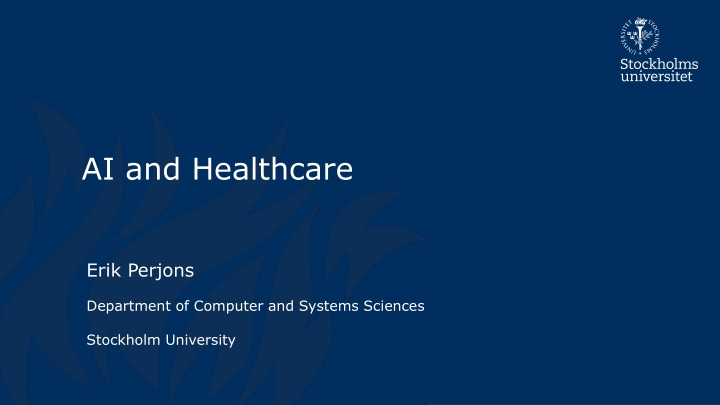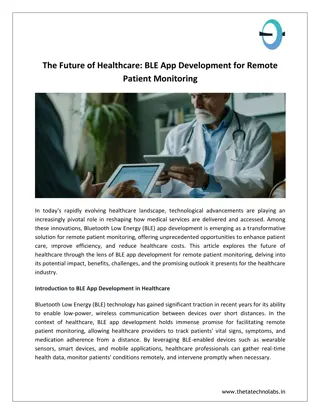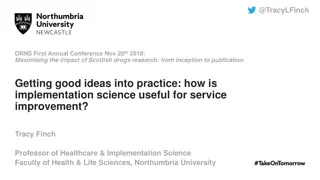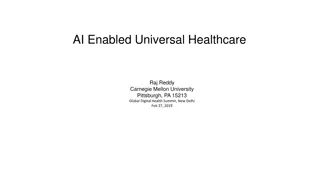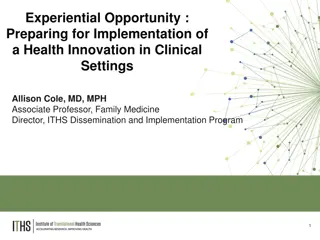The Potential of AI in Healthcare and Its Implementation Challenges
AI has the potential to revolutionize healthcare by utilizing vast amounts of data for analysis and improving key healthcare activities like disease diagnosis. However, existing AI solutions are sparsely implemented due to limitations in task focus, integration into clinical processes, and electronic record systems. Healthcare systems' complexity and data collection challenges also hinder widespread AI adoption in practical healthcare settings.
Download Presentation

Please find below an Image/Link to download the presentation.
The content on the website is provided AS IS for your information and personal use only. It may not be sold, licensed, or shared on other websites without obtaining consent from the author.If you encounter any issues during the download, it is possible that the publisher has removed the file from their server.
You are allowed to download the files provided on this website for personal or commercial use, subject to the condition that they are used lawfully. All files are the property of their respective owners.
The content on the website is provided AS IS for your information and personal use only. It may not be sold, licensed, or shared on other websites without obtaining consent from the author.
E N D
Presentation Transcript
AI and Healthcare Erik Perjons Department of Computer and Systems Sciences Stockholm University
Why AI in healtcare? AI has the potential to transform healthcare since healthcare is producing a large amount of clinical and administrative data This large amount of data can be used for analysis Moreover, research studies have shown that AI can carry out many key healthcare activities better than, or as well as, humans, such as diagnosing diseases, for example by analyzing radiology images (Davenport, T., & Kalakota, R. (2019). The potential for artificial intelligence in healthcare. Future healthcare journal, 6(2), 94)
AI is sparsely implemented Today, AI solutions are sparsely implemented in practical healthcare Existing AI solutions are mainly supporting the individual functions in healthcare, like radiology and pathology image analysis (Davenport, T., & Kalakota, R. (2019). The potential for artificial intelligence in healthcare. Future healthcare journal, 6(2), 94)
Why is AI sparsely implemented? 1(2) According to Davenport and Kalakota (2019), two major reasons for AI being sparsely implemented in practical healthcare are: AI solutions are focusing on limited tasks and are rarely integrated into the clinical processes Moreover, AI is not implemented in electronic record systems (EHR). Therefore, AI is not part of the system that most healthcare personnel use for their day-to-day work (Davenport, T., & Kalakota, R. (2019). The potential for artificial intelligence in healthcare. Future healthcare journal, 6(2), 94)
Why is AI sparsely implemented? 2(2) Panch et al. (2014) add additional important reasons for AI being sparsely implemented in practical healthcare are: Healthcare systems are complex and fragmented, and will not easily change as a result of new technology Healthcare organisations lack the capacity to collect the necessary training data of sufficient quality - while also respecting ethical principles and legal constraints (Panch, T., Mattie, H., & Celi, L. A. (2019). The inconvenient truth about AI in healthcare. NPJ digital medicine, 2(1), 1-3.)
AI technologies in healthcare Note, according to Devenport and Kalakota (2019), AI is not one technology, but rather a collection of them. Examples pf AI technologies: Machine learning Natural language processing Rule based expert system Physical robots Robotic process automation (Davenport, T., & Kalakota, R. (2019). The potential for artificial intelligence in healthcare. Future healthcare journal, 6(2), 94)
Machine learning Traditional machine learning is the most common application in healthcare. This application is mostly using supervised learning, which requires a training datasets to be used to be able to do the work Supervised learning systems are supporting the making of diagnosis, and predicting what treatment protocols are likely to be successful for a patient, based on various patient attributes and the treatment context (Davenport, T., & Kalakota, R. (2019). The potential for artificial intelligence in healthcare. Future healthcare journal, 6(2), 94)
Neural network and deep learning A more complex form of supervised machine learning is the neural network. Neural network make use of a network of variables that associate inputs with outputs and create weights on these associations, in order to predict outcome A neural network can also have variables on many different so called hidden layers, called deep neural network or deep learning Deep learning has been very successful for identifying clinically relevant features in imaging data - beyond what can be perceived by the human eye Deep learning is also increasingly used for speech recognition in NLP, see next slide (Davenport, T., & Kalakota, R. (2019). The potential for artificial intelligence in healthcare. Future healthcare journal, 6(2), 94)
Natural language processing Natural language processing (NLP) aims to make sense of human language. NLP includes application such as speech recognition, text analysis, translation. In healthcare, NLP can, for example, be used for analyzing unstructured clinical notes and supporting the transformation from speech to text (Davenport, T., & Kalakota, R. (2019). The potential for artificial intelligence in healthcare. Future healthcare journal, 6(2), 94)
Rule based expert system 1(2) Rule based expert system - require human experts and knowledge engineers to construct a series of rules in a particular knowledge domain, which will be the base for the expert system Rule based expert systems in healthcare - are the base for many clinical decision support system Rule based expert systems - are also be part of many medical record systems (i.e. EHR systems), for example, they provide functionality to warn for drug-to-drug interactions, and support the physician of making diagnoses (Davenport, T., & Kalakota, R. (2019). The potential for artificial intelligence in healthcare. Future healthcare journal, 6(2), 94)
Rule based expert system 2(2) The limitation of rule based expert systems: Rule based expert systems - work well if the rules are not so many. However, if number of rules is over several thousand, it is hard to maintain the rules, for example, the rules soon start to conflict with each other. Moreover, if the knowledge domain changes, rules need to change, which may be time- consuming, especially if the rules are many, and related on each other Therefore, due to this limitations, rule based expert systems are being replaced by systems based on ML algorithms (Davenport, T., & Kalakota, R. (2019). The potential for artificial intelligence in healthcare. Future healthcare journal, 6(2), 94)
Physical robots Physical robots - perform pre-defined tasks in factories and warehouses, like lifting and assembling objects Applied in healthcare are surgical robots which can improve the surgeons ability to see and make tasks more precise Moreover, physical robots are also becoming more intelligent, as other AI capabilities are being embedded in their operating systems. (Davenport, T., & Kalakota, R. (2019). The potential for artificial intelligence in healthcare. Future healthcare journal, 6(2), 94)
Robotic process automation (RPA) Robotic process automation (RPA) record the keyboard and mouse actions of a human being, and repeat these actions automatically RPA does not involve physical robots instead RPA is a form of software RPA act like a semi-intelligent user of the systems, following a script or a set of rules based on actions done by human beings RPA can be used in healthcare for updating patient records, billing or other administrative tasks Moreover, RPA can be used in combination with other technologies, for example combining image recognition and RPA, where RPA can be used for extract data from the recognitions of images and update EHR system with this data (Davenport, T., & Kalakota, R. (2019). The potential for artificial intelligence in healthcare. Future healthcare journal, 6(2), 94)
AI technolgies can be combined AI technologies are being more and more combined and integrated, for example: physical robots are getting AI-based features image recognition is being integrated with RPA. (Davenport, T., & Kalakota, R. (2019). The potential for artificial intelligence in healthcare. Future healthcare journal, 6(2), 94)
AI application areas Example of AI application areas in healthcare: Diagnosis and treatment Patient engagement and adherence Administrative activities (Davenport, T., & Kalakota, R. (2019). The potential for artificial intelligence in healthcare. Future healthcare journal, 6(2), 94)
Diagnosis and treatment 1(3) IBM's Watson has received a lot of attention for its application in diagnosis and treatment area, particularly cancer diagnosis and treatment Watson consisted of a set of cognitive services , employing a combination of machine learning and NLP technologies However, IBM s Watson s application in healthcare has not been a success: Watson has not been able to handle different types of cancer Watson has also been hard to integrate into care processes and systems (Davenport, T., & Kalakota, R. (2019). The potential for artificial intelligence in healthcare. Future healthcare journal, 6(2), 94)
Diagnosis and treatment 2(3) Other examples of the use of AI for diagnosis and treatment: Several organizations work on ML based solutions to better understand the how different genetic variants of humans will response to different treatments, such as drugs and protocols. Organizations are also working on ML based solution to predict populations at risk of particular diseases, high-risk conditions or to predict hospital readmission (Davenport, T., & Kalakota, R. (2019). The potential for artificial intelligence in healthcare. Future healthcare journal, 6(2), 94)
Diagnosis and treatment 3(3) Drawbacks of using AI in the application of diagnosis and treatment: To embed AI-based diagnosis and treatment recommendations into clinical workflows and EHR systems has not been successful According to Davenport and Kalakota (2019), such integration issues have probably been a greater barrier to broad implementation of AI than any inability to provide accurate and effective recommendations (Davenport, T., & Kalakota, R. (2019). The potential for artificial intelligence in healthcare. Future healthcare journal, 6(2), 94)
Patient engagement and adherence 1(2) Patients engagement in their own well-being and care are important for receiving better outcome in healthcare The major problem is that the patient may not make necessary behavioral adjustment, that is, does not follow a course of treatment or take the prescribed drugs (Davenport, T., & Kalakota, R. (2019). The potential for artificial intelligence in healthcare. Future healthcare journal, 6(2), 94)
Patient engagement and adherence 2(2) Therefore, ML and business rules engines can be used to support patient engagement and adherence, by: sending message alert to patients, providing targeted content given the patients status and characteristics, tailoring recommendations by comparing patient data to other effective treatment pathways for similar cohorts nudging patient behavior in a more anticipatory way (Davenport, T., & Kalakota, R. (2019). The potential for artificial intelligence in healthcare. Future healthcare journal, 6(2), 94)
Administrative activities Different AI technologies can be used for administrative tasks: RPA can be used for a variety of applications in healthcare, like managing medical records NLP can be applied in chatbots for patient interaction ML could be used to verify whether millions of insurance claims are correct, for example, by applying probabilistic matching of data across different databases (Davenport, T., & Kalakota, R. (2019). The potential for artificial intelligence in healthcare. Future healthcare journal, 6(2), 94)
Implication for healthcare workforce 1(2) According to Davenport and Kalakota (2019) estimate that it will take 20 years before will see any substantial change in healthcare employment due to AI Instead, there is also the possibility that new jobs for working with AI technologies are created (Davenport, T., & Kalakota, R. (2019). The potential for artificial intelligence in healthcare. Future healthcare journal, 6(2), 94)
Implication for healthcare workforce 2(2) The area where most healthcare jobs will be automated are those dealing with digital information, radiology and pathology However, for example, not even radiologist jobs will not disappear in the near future, and maybe not in the long term either see next slides (Davenport, T., & Kalakota, R. (2019). The potential for artificial intelligence in healthcare. Future healthcare journal, 6(2), 94)
Implication for radiology 1(2) Today, radiology AI systems can only perform single tasks. Radiology AI systems cannot fully identify all potential findings in medical images. Radiologist are still needed for that Radiologists also do a lot of other thing than just read and interpret images: radiologists relate findings from images to other medical records and test results radiologists consult with other physicians regarding diagnosis and treatment radiologists discuss procedures and results with patients radiologists define the technical parameters of imaging examinations. The parameters need to be tailored to the patient's condition (Davenport, T., & Kalakota, R. (2019). The potential for artificial intelligence in healthcare. Future healthcare journal, 6(2), 94)
Implication for radiology 2(2) Moreover, for employing full scale AI-based image work: clinical processes need to be changed, which will take time an aggregated repository of radiology images is required for training the AI system, but such an aggregated repository is lacking today changes in medical regulation and health insurance contracts for automated image analysis are needed (Davenport, T., & Kalakota, R. (2019). The potential for artificial intelligence in healthcare. Future healthcare journal, 6(2), 94)
To summarize 1(2) The greatest challenge to AI is to ensure its adoption in daily clinical practice. There are a number of challenges to overcome to achieve this. Therefore, Davenport and Kalakota (2019) estimate that we will see a limited use of AI in clinical practice within 5 years and more extensive use within 10 (Davenport, T., & Kalakota, R. (2019). The potential for artificial intelligence in healthcare. Future healthcare journal, 6(2), 94)
To summarize 2(2) Moreover, AI systems will not replace human clinicians on a large scale, but rather will augment their efforts to care for patients . According to Davenport and Kalakota (2019) it might take 20 years before will see any substantial change in healthcare employment (Davenport, T., & Kalakota, R. (2019). The potential for artificial intelligence in healthcare. Future healthcare journal, 6(2), 94)
